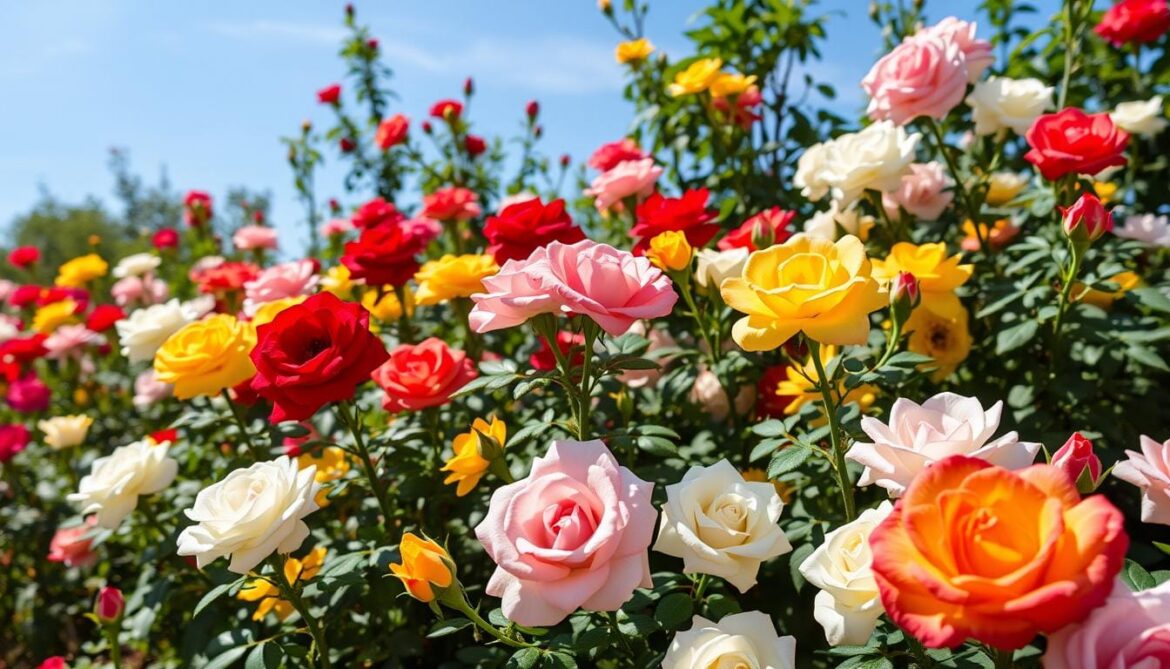I’ve always loved roses, but keeping them healthy was a big challenge. Fighting off diseases and pests was a never-ending task. That changed when I found disease-resistant rose varieties. These roses made my garden care easier, letting me enjoy their beauty without constant worry.
In this guide, we’ll look at the top disease-resistant rose types. From classic to modern, these roses are perfect for any gardener. Whether you’re new to roses or have been growing them for years, this guide will help you create a beautiful, easy-to-care-for rose garden.
Key Takeaways
- Disease-resistant rose varieties offer beauty without the need for constant chemical spraying and intensive care
- These hardy, low-maintenance roses are ideal for gardeners who prefer natural, eco-friendly gardening methods
- The guide covers a range of disease-resistant rose types, including classic and modern cultivars
- Discover the benefits of growing disease-resistant roses, from reduced maintenance to enhanced garden aesthetics
- Learn how to choose the right disease-resistant rose for your climate and growing conditions
Understanding Rose Diseases
To grow beautiful pest-resistant roses and durable garden roses, knowing common diseases is key. Rose lovers need to know the main problems that can harm their flowers.
Common Rose Diseases
Mildew, blackspot, and rust are common rose diseases. Mildew looks like a white powder on leaves and stems, loving warm, humid air. Blackspot shows as dark spots on leaves, causing them to fall early. Rust has orange or yellow spots on the underside of leaves.
Signs and Symptoms of Infected Roses
- Discolored or spotted leaves
- Wilting or stunted growth
- Premature defoliation
- Distorted or malformed blooms
Prevention Strategies
To keep pest-resistant roses and durable garden roses healthy, gardeners should use several prevention methods. Choose disease-resistant varieties, give them the best growing conditions, and care for them well. This includes pruning, watering, and fertilizing. By knowing the diseases and taking action early, gardeners can have beautiful, healthy gardens without needing many fungicides.
“More than 200 rose cultivars were tested for disease resistance by the University of Tennessee Institute of Agriculture, and only about 10 percent displayed acceptable levels of resistance to black spot and cercospora leaf spot.”
It’s important to watch for disease signs and act fast to keep pest-resistant roses and durable garden roses healthy. By understanding and preventing common diseases, gardeners can enjoy a vibrant, easy-to-care-for rose garden for many years.
Benefits of Disease Resistant Roses
Disease-resistant roses offer many benefits for gardeners and homeowners. They are easy to care for and last longer. This makes your garden look better.
Reduced Maintenance Efforts
Disease-resistant roses are a big help for busy gardeners. They don’t get sick as often as other roses. This means you don’t have to spray them as much or use chemicals.
You can enjoy their beauty without spending too much time on them. This lets you relax and enjoy your garden more.
Longer Lifespan
These roses live longer because they don’t get sick as easily. Low-maintenance roses stay healthy and beautiful for years. They are a great choice for anyone who wants a beautiful garden that lasts.
Enhanced Garden Aesthetics
Healthy long-lasting landscape roses make your garden look better. They don’t get sick or lose their leaves early. This keeps them looking great all season.
They add beauty to your garden without a lot of work. You can enjoy the beauty of roses without much effort.
| Rose Variety | ARS Rating | Year Introduced |
|---|---|---|
| R. banksiae | 9.2 | 1807 |
| Clair Matin | 8.8 | 1960 |
| Kiftsgate | 8.8 | 1954 |
| Sally Holmes | 8.9 | 1976 |
| Gartendirektor Otto Linne | 8.8 | 1934 |
| Penelope | 8.8 | 1924 |
“Roses like Knockout series are changing the landscape of rose growing by requiring much less maintenance and reducing the need for fungicide applications.”
Factors Influencing Disease Resistance
Growing healthy, disease-resistant rose plants involves several key factors. Genetics, environmental conditions, and proper care practices are crucial. These elements help drought-tolerant rose plants and hardy rose bushes thrive in your garden.
Genetics of Rose Varieties
Some rose varieties naturally resist diseases better than others. Old gallica and rugosa roses, for example, show strong resistance to common rose diseases. The genetic makeup of a rose variety greatly affects its disease resistance.
Environmental Factors
The environment around a rose plant affects its disease susceptibility. Humidity, air circulation, and temperature are key factors. Roses in humid, still air are more likely to get fungal infections. Good air flow helps prevent these diseases.
Proper Care Practices
How we care for our rose plants impacts their disease resistance. Watering, pruning, and fertilization all affect a rose’s health. Using best practices in these areas boosts a rose’s ability to fight off infections.
Understanding and addressing these factors helps gardeners grow a disease-resistant rose garden. This garden requires less care and offers lasting beauty.
Top Most Disease Resistant Roses
Creating a beautiful, low-maintenance rose garden is easy with disease-resistant roses. These hardy plants look great and need little care. Here are some top picks for disease-resistant roses that will thrive in your garden.
Knock Out Roses
The Knock Out rose series is famous for its disease resistance and constant blooms. These tough plants have vibrant flowers in many colors. They’re great for any garden because they fight off common rose diseases well.
Easy Elegance Roses
The Easy Elegance rose collection has many disease-resistant types. They come in different shapes and colors. These roses are known for their health and long-lasting flowers. They’re perfect for adding beauty to your garden.
Drift Roses
Drift roses are low-growing and spread out, fighting off diseases well. They’re great for adding color to your garden with little care. Their continuous blooms make them a low-maintenance choice.
Other notable roses include ‘Roseraie de L’Hay’, ‘Boscobel’, and ‘Lady of Shalott’. Each has unique features and is very healthy. Adding these roses to your garden means less work and more beauty.
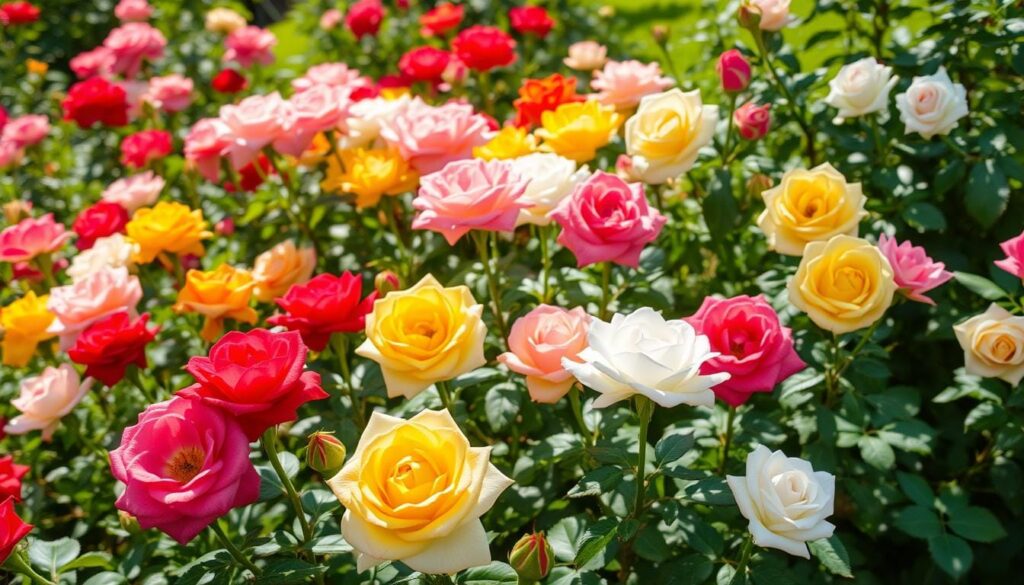
| Rose Variety | Characteristics | Disease Resistance |
|---|---|---|
| Knock Out Rose | Shrubby, continuous blooming, vibrant colors | Highly disease-resistant |
| Easy Elegance Roses | Diverse forms and colors, long-lasting blooms | Excellent disease resistance |
| Drift Roses | Compact, ground-cover habit, continuous blooms | Highly resistant to common rose diseases |
Choosing the Right Disease Resistant Rose for Your Garden
When picking disease-resistant roses, think about your climate and soil. Different roses do well in different weather. For example, ‘Westerland’ roses love warm weather, while ‘Bordeaux’ can handle cold down to -40°F.
It’s also key to know your soil’s quality. Roses like slightly acidic to neutral soil that drains well. Knowing your soil’s pH and texture helps your drought-tolerant rose plants and hardy rose bushes grow best.
Assessing Climate Compatibility
To find the right rose for your climate, look at these points:
- Hardiness zones: Pick roses that fit your local climate’s zones.
- Temperature extremes: Choose ones that handle your area’s hottest and coldest.
- Precipitation patterns: Find roses that do well in your area’s rain or dry spells.
- Sunlight exposure: Make sure your roses get 6-8 hours of direct sun daily.
Considering Your Garden’s Soil Quality
Check your soil’s type and pH for roses:
- Soil type: Roses like loamy, well-draining soil. Avoid clay or sand.
- Soil pH: Aim for a pH between 6.0 and 7.0, slightly acidic to neutral.
- Nutrient content: Your soil should have enough nitrogen, phosphorus, and potassium.
- Drainage: Good drainage is key to prevent root rot and other moisture problems.
By thinking about your climate and soil, you can pick the best drought-tolerant rose plants and hardy rose bushes for your garden. This way, your roses will thrive and stay disease-free.
Planting Disease Resistant Roses
When growing easy-care rose cultivars and durable garden roses, planting right is key. By using the best methods, we help our disease-resistant roses start strong and grow well in the garden.
Ideal Soil Preparation
Roses love soil that drains well and is full of nutrients. To make the best soil, mix peat moss, pine bark, and black topsoil together. This mix gives your disease-resistant roses the right amount of organic matter, drainage, and nutrients.
Optimal Spacing Requirements
Spacing is important for air and to stop diseases. Plant disease-resistant roses with enough space for them to grow. This helps them grow healthy and keeps diseases away.
Proper Planting Techniques
Make sure to plant roses in full sun, getting at least six hours of direct sunlight. Add Espoma Bio-tone Starter Plus Fertilizer to feed the roots and help them grow strong. Follow the right steps for planting depth and soil to help your easy-care rose cultivars succeed.
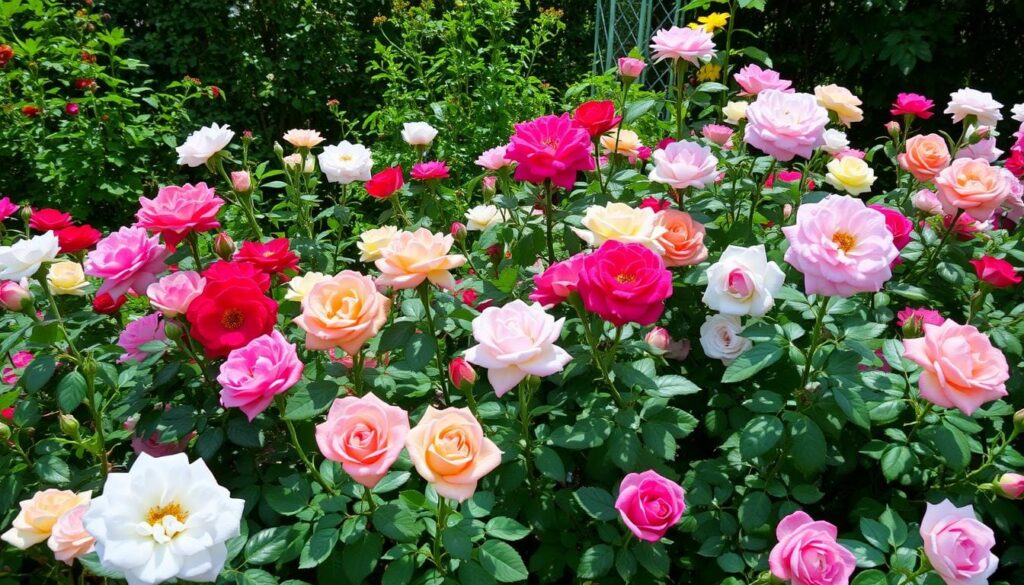
By focusing on the right soil, spacing, and planting, we create perfect conditions for our durable garden roses. With a bit of care at the start, we’ll enjoy a beautiful, easy-to-care-for rose garden for many years.
Watering Best Practices for Disease Resistance
Proper watering is key to keeping your drought-tolerant rose plants healthy. Knowing how much water they need and using the right techniques helps fight off diseases. This way, you can keep your roses looking great without much effort.
Understanding Watering Needs
Roses need different amounts of water based on their type and where you live. Generally, they should get water that soaks the soil at least 1 foot deep. This helps their roots grow strong and makes them more drought-resistant.
Techniques for Effective Watering
- Use drip irrigation or water at the base of the plant to keep the foliage dry and reduce the risk of disease.
- Water in the morning to allow the foliage to dry before nightfall, as wet leaves can promote the growth of fungal pathogens.
- Apply water slowly enough to prevent surface runoff, ensuring the soil can absorb the moisture effectively.
Importance of Drainage
Good drainage is vital for your roses’ health. It prevents waterlogged soil and root rot. This keeps your roses strong and disease-free.
“Watering roses from below, at ground level, helps prevent fungal diseases and leaf spots.”
By watering your roses right, you help them stay healthy and disease-free. This leads to beautiful blooms that last a long time.
Fertilization for Healthy Roses
Proper fertilization is key for our roses to stay healthy and strong. Knowing the right fertilizers, how often to use them, and spotting nutrient deficiencies helps. This way, our roses will bloom well and fight off diseases.
Types of Fertilizers
Roses need nitrogen, phosphorus, and potassium to grow well. Organic fertilizers like Espoma Rose-tone and Dr. Earth Rose & Flower Fertilizer give these nutrients. They also have extra nutrients and good microbes. Inorganic fertilizers are more concentrated but don’t improve soil like organics do.
Frequency of Application
- Newly planted roses need rich soil and a slow-release fertilizer every 3 to 4 weeks. Add bone meal for strong roots.
- Older roses get a high-nitrogen fertilizer or alfalfa meal in spring. This helps them grow leaves and flowers.
- Roses in pots might need more fertilizer because water washes away nutrients quickly.
Signs of Nutrient Deficiency
Watch for yellow leaves or slow growth in your roses. These signs mean they need more nutrients. Keeping the soil pH between 6.0-7.0 helps them absorb nutrients better.
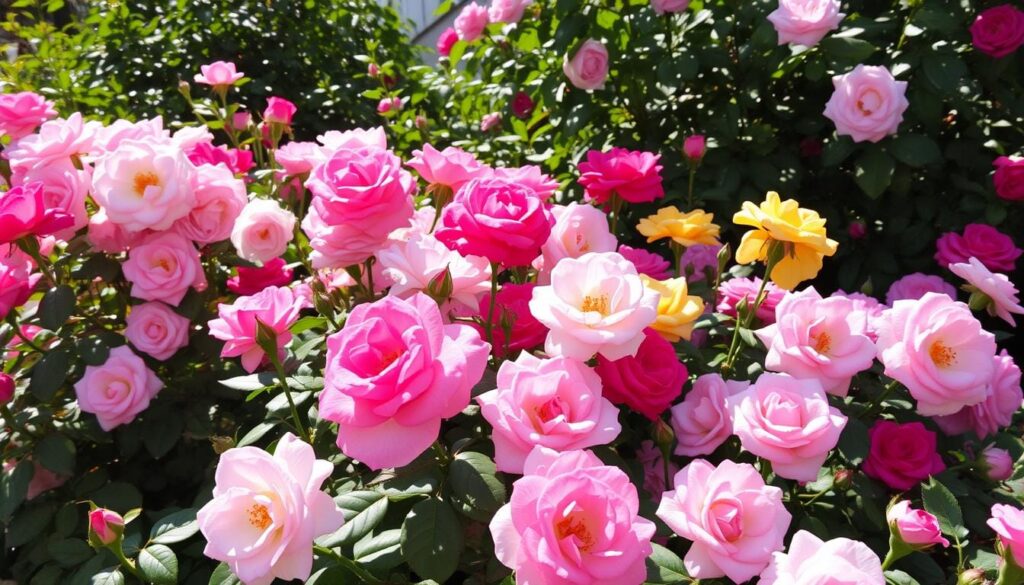
Knowing about fertilizers and feeding our roses regularly helps them stay healthy. This makes them strong against diseases and beautiful in our gardens.
Pruning Disease Resistant Roses
Proper pruning is key to keeping your low-maintenance roses and hardy rose bushes healthy. The right timing and techniques can prevent disease and promote strong growth.
When to Prune
The best time to prune disease resistant roses is in late winter or early spring. This is right before new growth starts. It lets the plants heal and grow strong before the growing season.
Techniques for Effective Pruning
- Remove dead, diseased, or crossing branches to improve air circulation.
- Cut at a 45-degree angle just above an outward-facing bud or leaf node. This helps the plant grow outward.
- Use clean, sharp pruning tools to make clean cuts and prevent disease spread.
Tools Needed for Pruning
- Bypass pruners for cutting stems up to 1/2 inch in diameter
- Lopping shears for larger branches up to 1 inch in diameter
- Pruning saw for cutting thicker branches
- Gloves to protect your hands
Remember, different rose varieties have specific pruning needs. It’s important to research what your low-maintenance roses or hardy rose bushes need. Proper pruning promotes healthy growth and prevents disease, keeping your rose garden thriving for years.
| Rose Variety | Pruning Technique | Recommended Tools |
|---|---|---|
| Knock Out Roses | Cut back by one-third to one-half in late winter | Bypass pruners, lopping shears |
| Easy Elegance Roses | Prune lightly in early spring, removing dead or damaged canes | Bypass pruners |
| Drift Roses | Prune to shape in early spring, cutting back by one-half | Bypass pruners, pruning saw |
Pest Management for Roses
To keep our rose gardens healthy and pest-free, we need to be proactive. We face challenges like aphids, Japanese beetles, and black spot. These issues can harm our pest-resistant roses and easy-care rose cultivars.
Common Pests Affecting Roses
Rose gardens often deal with pests like:
- Aphids, which can quickly infest and damage the entire plant
- Spider mites, tiny creatures that feed on the leaves
- Thrips, causing streaked or distorted blossom petals
- Beetles, such as the hoplia and fuller rose beetles, chewing on flowers and foliage
- Leafcutting bees, essential pollinators that can also damage leaves
- Rose curculio, a snout weevil that infests the plant
Integrated Pest Management Strategies
We use various strategies to manage pests:
- Encouraging beneficial insects, such as ladybugs, to naturally control pests
- Using organic pest control methods, like neem oil or insecticidal soaps, to target specific pests
- Maintaining overall plant health through proper watering, fertilization, and pruning practices
- Regularly inspecting our roses and acting quickly to address any issues before they escalate
These holistic approaches help us avoid harsh chemicals. They ensure our pest-resistant roses and easy-care rose cultivars stay healthy for a long time.
“Integrated pest management is a sustainable approach to managing pests that combines biological, cultural, mechanical, and chemical tools in a way that minimizes economic, health, and environmental risks.”
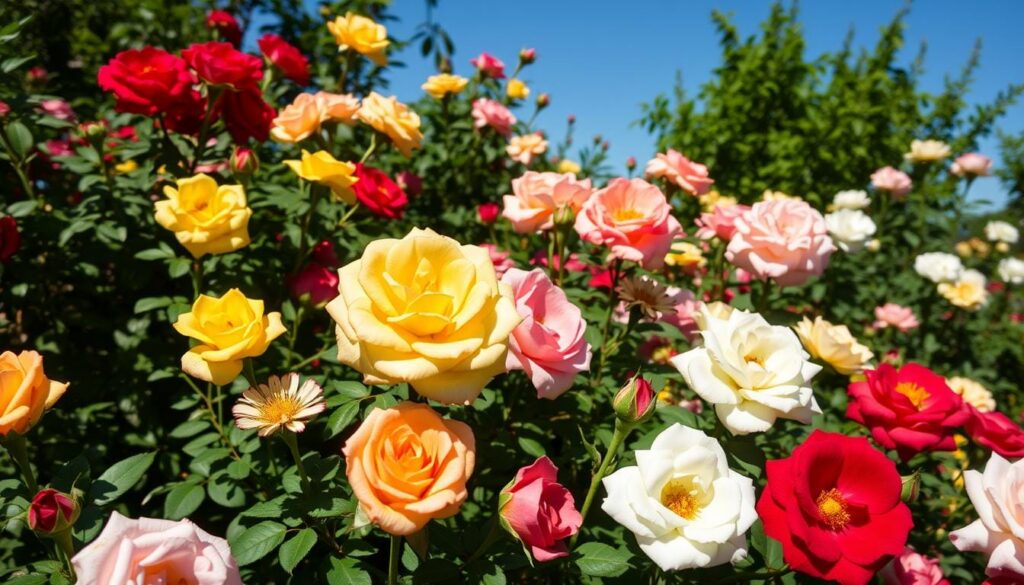
Maintaining Optimal Growth Conditions
To grow healthy drought-tolerant rose plants, you need to balance light, temperature, and air. Knowing what your durable garden roses need helps you create the perfect environment. This ensures they thrive for a long time.
Light Requirements for Roses
Roses love full sun, needing at least 6 hours of direct sunlight a day. But, some can handle partial shade. Choose your rose plants based on their light needs to get the best growth and blooms.
Temperature Considerations
Each rose type has its own temperature tolerance. Some drought-tolerant rose plants can handle cold, while others prefer warmth. Make sure to plant your durable garden roses in the right zone. This keeps them in their ideal temperature range.
Humidity and Air Circulation
- Good air flow stops common rose diseases like powdery mildew and black spot.
- Don’t plant roses where air is still or humidity is high. These conditions help fungi grow.
- Regular pruning improves air flow and lowers disease risk.
Think about the light, temperature, and air needs of your drought-tolerant rose plants and durable garden roses. This way, you can give them the best conditions for a healthy, disease-free garden.
“Roses should receive six to eight hours of sunlight daily for the best show of flowers and healthiest plants.”
Seasonal Care for Roses
To keep long-lasting landscape roses and hardy rose bushes healthy, we need to care for them all year. As seasons change, so must our rose care. This ensures these beautiful flowers bloom all year.
Spring Care Tips
In spring, new growth starts, and it’s time to prune and fertilize. Remove dead or damaged canes to promote strong growth. Also, a balanced rose fertilizer will help our long-lasting landscape roses grow well.
Summer Maintenance Strategies
In summer, keeping our hardy rose bushes watered is crucial. Deadheading spent blooms helps the plant focus on making more flowers. This keeps our garden looking vibrant all season.
Fall Preparation Actions
As fall comes, we need to change our care again. We’ll water and fertilize less to help our roses get ready for winter. Adding mulch around the plants also protects their roots from frost. This prepares our long-lasting landscape roses and hardy rose bushes for the cold months.
By following these seasonal care tips, our rose garden stays lush and vibrant. It will also be disease-resistant all year. This gives us a stunning display of rose blooms.
Recognizing Issues Early
Choosing disease-resistant rose varieties is key to a healthy garden. But, you must still watch them closely. Regular checks and quick action are vital to stop problems early. This way, you can keep your roses safe and enjoy their beauty for many years.
Monitoring for Early Signs of Disease
Regularly checking your roses can help spot issues fast. Look for any unusual colors, spots, or growths. These could be signs of diseases like black spot or powdery mildew. Catching these early helps prevent big damage to your roses.
Prompt Action for Healthy Roses
If you see disease or pests, act fast. Remove any sick parts right away. This stops the problem from getting worse. Also, change your care routine if needed, like watering or using organic treatments, to help your roses get better.
Being alert and quick to act keeps your roses looking great. With a proactive mindset, your roses will stay healthy and make your garden beautiful.
In the last two decades, the NYBG’s rose curator replanted most of the Peggy Rockefeller Rose Garden to prioritize disease-resistant roses, recognizing the importance of early detection and intervention in maintaining their long-term health.
Incorporating Companion Plants
Companion planting is a great way to make our rose gardens healthy and beautiful. By picking plants that go well with our roses, we help our garden grow strong. This makes our outdoor space look even better.
Benefits of Companion Planting
Companion plants bring many benefits to our rose gardens. They attract good bugs like ladybugs and lacewings, which eat pests. Some plants even release chemicals that keep bad bugs away from our roses.
Also, some plants help the soil by adding nitrogen or making it easier for roots to grow. This is great for our long-lasting landscape roses and durable garden roses. Plus, they add color, texture, and interest, making our gardens more lively.
Best Companion Plants for Roses
When picking plants to go with our roses, we need to think about a few things. We should look at what plants like our climate and soil, and how they grow. Here are some good choices:
- Lavender: Its scent and ability to handle dry weather make it a great match for roses.
- Garlic: It keeps pests and diseases away from our roses.
- Marigolds: These bright flowers keep pests away and make the soil better.
- Basil: It’s good for cooking and keeps bugs away, helping our roses grow well.
By picking the right plants, we can make a beautiful rose garden. It will show off the beauty of our long-lasting landscape roses and durable garden roses, with the help of other plants.
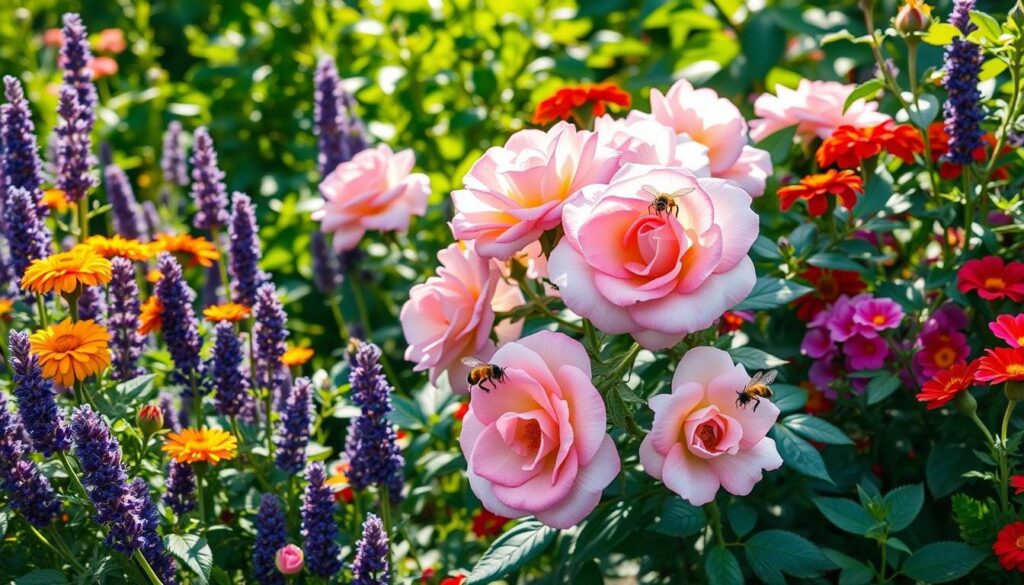
Resources for Further Learning
We love growing roses and always want to learn more. There are many resources to help us grow disease-resistant and easy-care roses.
Recommended Books and Guides
“The Rose Bible” by Rayford Clayton Reddell is a must-read. It covers rose history, selection, and care. “Roses for Dummies” by Lance Walheim is also great. It offers simple, practical advice for all rose gardeners.
Online Communities and Forums
Talking to other rose lovers is very helpful. Join the American Rose Society for lots of information. Their website, rose.org, has expert advice and tips. Garden.org is another great place for discussions and help.
Using these resources, we can learn more about growing healthy roses. We can also find tips for easy-care rose gardens.
“Growing roses is a lifelong journey of discovery, and with the right resources, we can all become master rose gardeners.”
Conclusion: Cultivating Disease Resistant Roses
Growing disease-resistant roses is a rewarding hobby. It brings beautiful, healthy plants to your garden with little need for chemicals. By picking the right roses and caring for them well, we can enjoy stunning displays with less work and better for the planet. Let’s dive into the world of disease-resistant roses for a greener, happier garden.
Final Thoughts on Gardening Success
Rose diseases, like Rose Rosette Disease, have hurt the rose industry and home gardens a lot. But, by focusing on the most disease-resistant roses, we can beat these challenges. With the right knowledge and effort, our gardens can bloom with vibrant, easy-to-care-for roses, adding beauty and happiness to our spaces.
Encouragement for Garden Enthusiasts
We, as garden lovers, can turn our gardens into havens of resilient, disease-resistant roses. By using the tips and strategies from this guide, we can keep our rose collections healthy and sustainable for a long time. Let’s keep exploring and celebrating the resilience and beauty of these flowers. Together, we can make gardens that inspire and bring joy for many years.
